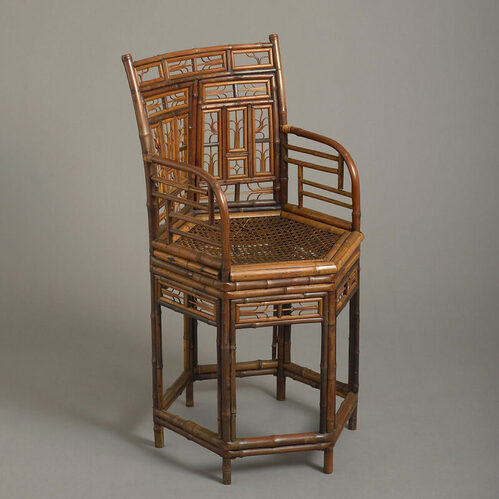0123-13
'Brighton Pavilion' Chair
China, Canton. Qing dynasty, c.1800
Bamboo wood; caned seat
H90 x W50 x D43 cm (35.5 x 19 3/4 x 17 in.)
A Chinese export bamboo chair of the so-called Brighton Pavilion type. Hexagonal in form with a caned seat and bamboo trimming strips, raised on six legs with aprons of bamboo and split bamboo of contrasting colour, the stretchers of typical bamboo construction where the bamboo is cut with a V-shaped indent and bent around the leg. The back with two upright rectangular panels formed to follow the profile of the hexagonal seat and surmounted by a horizontal panel curved to fit the back. The arms are formed of a curved shape probably a continuation of two legs and are tenoned and tied into the back uprights.
Chinese, Canton, circa 1800.
Bamboo furniture became highly fashionable in England after the completion of the Royal Pavilion in Brighton, created by the architect Henry Holland around 1801 for George, Prince of Wales, the future King George IV and extended by John Nash between 1815 and 1822, and it is his work that is visible today.
Other hexagonal chairs still exist as furnishings of the Royal Pavilion in Brighton, although these have a curved back following the basic design of a Chinese ‘horseshoe’ armchair.
'Brighton Pavilion' Chair
China, Canton. Qing dynasty, c.1800
Bamboo wood; caned seat
H90 x W50 x D43 cm (35.5 x 19 3/4 x 17 in.)
A Chinese export bamboo chair of the so-called Brighton Pavilion type. Hexagonal in form with a caned seat and bamboo trimming strips, raised on six legs with aprons of bamboo and split bamboo of contrasting colour, the stretchers of typical bamboo construction where the bamboo is cut with a V-shaped indent and bent around the leg. The back with two upright rectangular panels formed to follow the profile of the hexagonal seat and surmounted by a horizontal panel curved to fit the back. The arms are formed of a curved shape probably a continuation of two legs and are tenoned and tied into the back uprights.
Chinese, Canton, circa 1800.
Bamboo furniture became highly fashionable in England after the completion of the Royal Pavilion in Brighton, created by the architect Henry Holland around 1801 for George, Prince of Wales, the future King George IV and extended by John Nash between 1815 and 1822, and it is his work that is visible today.
Other hexagonal chairs still exist as furnishings of the Royal Pavilion in Brighton, although these have a curved back following the basic design of a Chinese ‘horseshoe’ armchair.
